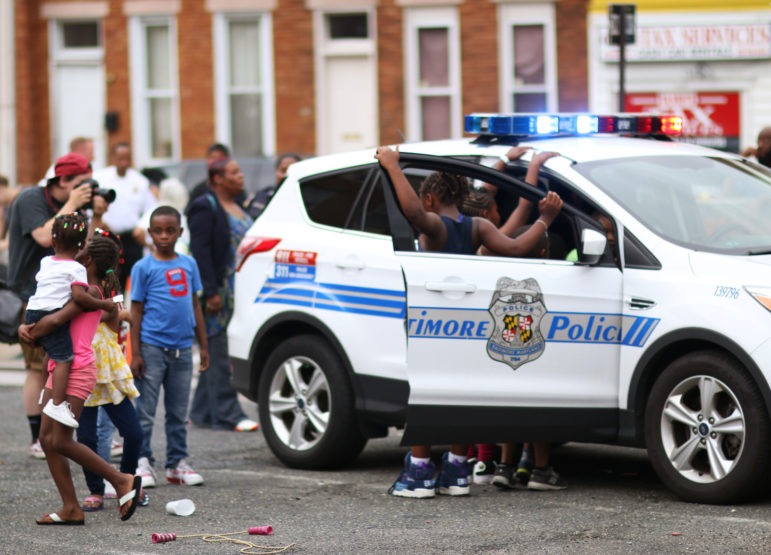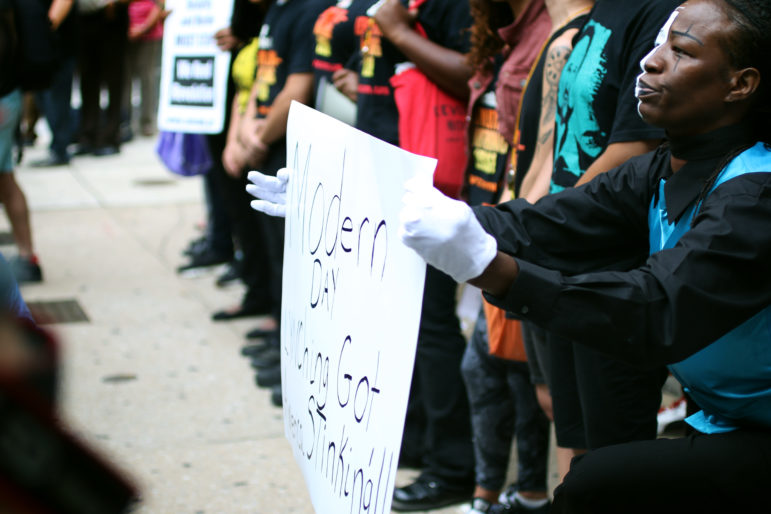BALTIMORE — The rumors were out a few days ago that Officer Caesar Goodson had been acquitted on murder and other charges in the death of Freddie Gray, and the streets around the courthouse were filled with protesters. Among them, a black mother dressed as a mime holding a sign on one hand reading: “Modern day lynching got America stinking,” while the other hand pulled a luggage strap wrapped around her neck symbolizing a noose.
“I’m telling you, don’t touch my baby. I only got one,” she yelled, her face half painted in white. “The truth is that somebody needs to be held accountable.”
I asked a resident standing outside the courthouse whether he knew of any protests planned that day. “There’s gonna be something at North-Penn. The metro takes you right there,” said James Gantt, who used to be a correctional officer, then a cab driver, then a tourist guide, but now describes himself only as a poet. Gantt, who calls himself a “Niggerologist” on his business card, said he’s a representative for the National Coalition of Blacks for Reparations in America.
 Later in the afternoon, I took a train to North-Penn station, about three miles north west of the city center. As soon as I got out of the station, I found myself in front of the CVS store I saw burning on live TV during the riots following Gray’s death. A little over a year ago, the anger of this community had turned into violence filled with fire, looting and massive disorder as National Guard and police clashed with protesters in clouds of tear gas.
Later in the afternoon, I took a train to North-Penn station, about three miles north west of the city center. As soon as I got out of the station, I found myself in front of the CVS store I saw burning on live TV during the riots following Gray’s death. A little over a year ago, the anger of this community had turned into violence filled with fire, looting and massive disorder as National Guard and police clashed with protesters in clouds of tear gas.
Last Thursday evening, however, the scene was startlingly different. The city had prepared for the worst but the worst never came. Instead, after a spasm of frustration at a perceived injustice, life turned toward the quotidian.
A handful of people lined up in front of a fried crab truck ready to buy early dinner.
Commuters walked to and from the Metro station minding their business. No sensible tension was in the air.
A few police officers stood by watching, while others patrolled the neighborhood in small groups, though their presence never felt overwhelming.

Marco Poggio
A mime artist simulating a hanging during a protest following the acquittal from murder charges of one of the police officers involved in the death of Baltimore resident Freddie Gray.
The lack of a large scale protest speaks to what many here said was a lack of faith in the institutions that govern their lives. Young people on the block were not surprised by the lack of violence, in part because they had long anticipated what the verdict would be. They learned to mistrust institutions when it comes to justice, in particular when the defendant is a cop.
[Related: Young Protesters React to Not-Guilty Verdict in Baltimore]
“The verdict was what everybody expected,” said a young resident of the neighborhood who did not wish to give his name. “What I can say is that despite what was expected, there was no violent reaction, you feel me?” The young man said he was proud his community was reacting with composure at the news of Goodson’s acquittal.
Journalists were the only people looking out of place.. A radio reporter walked around with a microphone and a recorder looking for people to interview. Three broadcast news trucks were parked on different sides of the intersection of Pennsylvania and West North avenues, with camera operators waiting hours for something to happen.
It never did.

Marco Poggio
Children playing around a police car near the intersection of West North and Pennsylvania avenues in Baltimore.
At about 7 p.m., they finally had something to shoot, though perhaps, not what they had expected. Half a block away from the intersection, in the parking lot of the Enoch Pratt Free Library, music was blasting from the speakers of an unusual venue: a police car, with a door open.
Children were playing basketball in the parking lot, shooting into a net brought there on a trailer. Police officers were dancing with the kids, trying to loosen up despite the weight of their belts and the loaded guns they carried. Some of them seemed to do pretty well. Media broadcasters and photographers were all around them, following what in that moment was news: no unrest whatsoever, but instead a quiet neighborhood and a police department trying to defuse tension and calm fears.
Earlier reports had given the National Guard on alert, ready to intervene in case protests got out of hand, but that scenario seemed unlikely in the face of this unremarkable tableau.
Still, the specter of last year’s demonstrations was vivid among residents, who that morning said that the not guilty verdict was more proof of the lack of accountability with their police department.
“They gotta do something, unless they want the city to go back crazy how it was,” said Roy, a young man living in the neighborhood who wouldn’t give me his last name.

Marco Poggio
A mime artist holds a sign reading “Modern day lynching got America stinking” during a protest following the acquittal from murder charges of one of the police officers involved in the death of Baltimore resident Freddie Gray.
A group of protesters showed up at around 8:00 p.m. They had signs and banners and were chanting “All night all day, we will chant for Freddie Gray.” Among them, I recognized some of the same people who awaited the verdict in front of the courthouse hours earlier. The protest was peaceful and didn’t last very long. Police officers guarded the intersection wearing regular uniforms rather than riot gear.
After sunset, the neighborhood turned quiet. Barred windows and collapsed roofs on West North Avenue gave away the poverty of this community, whose population is more than 90 percent African American, and whose sense of urban decay resembles that of many cities in the country.
Hours after the sunset, there were no protests or indication of any coming unrest. Police presence on the street appeared to wind down. The CVS store, which was rebuilt during the winter, had a sign hanging from its window that read “Now Open,” stood there untouched. The news crews started to pack up. By 11:00 p.m., when the streets were nearly empty.
A heavy rainfall came soon after. To me it felt like it washed away the anger and the expectations that filled the day. What remained was uncertainty and doubt.
This story was written by journalists from our New York Bureau.
More related articles:
Maryland Gov. Not Backing Proposed Juvenile Detention Facility in Baltimore
21 Years Later, Father Still Grieves Son’s Shooting by NY Police
March Until ‘Shoot First, Ask Questions Later’ by Police Stops
Unarmed St. Louis Teen Fatally Shot by Police; Protests Turn Violent Overnight